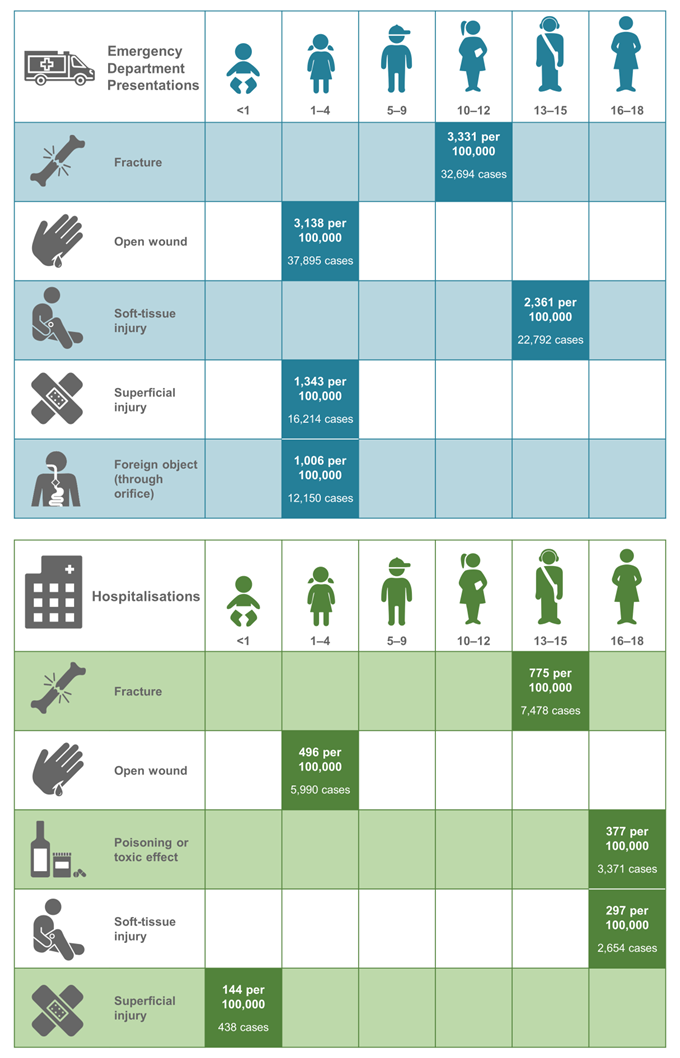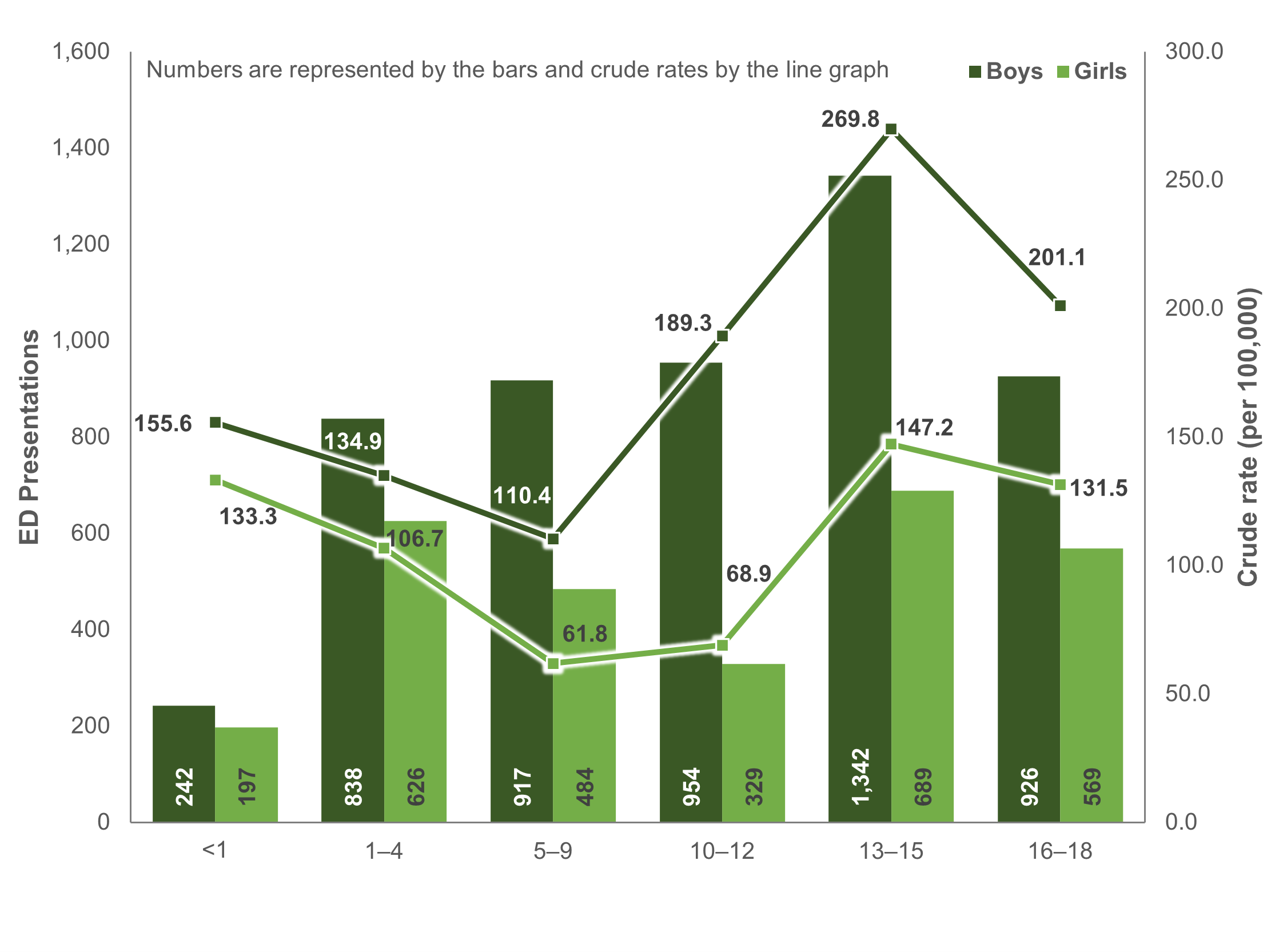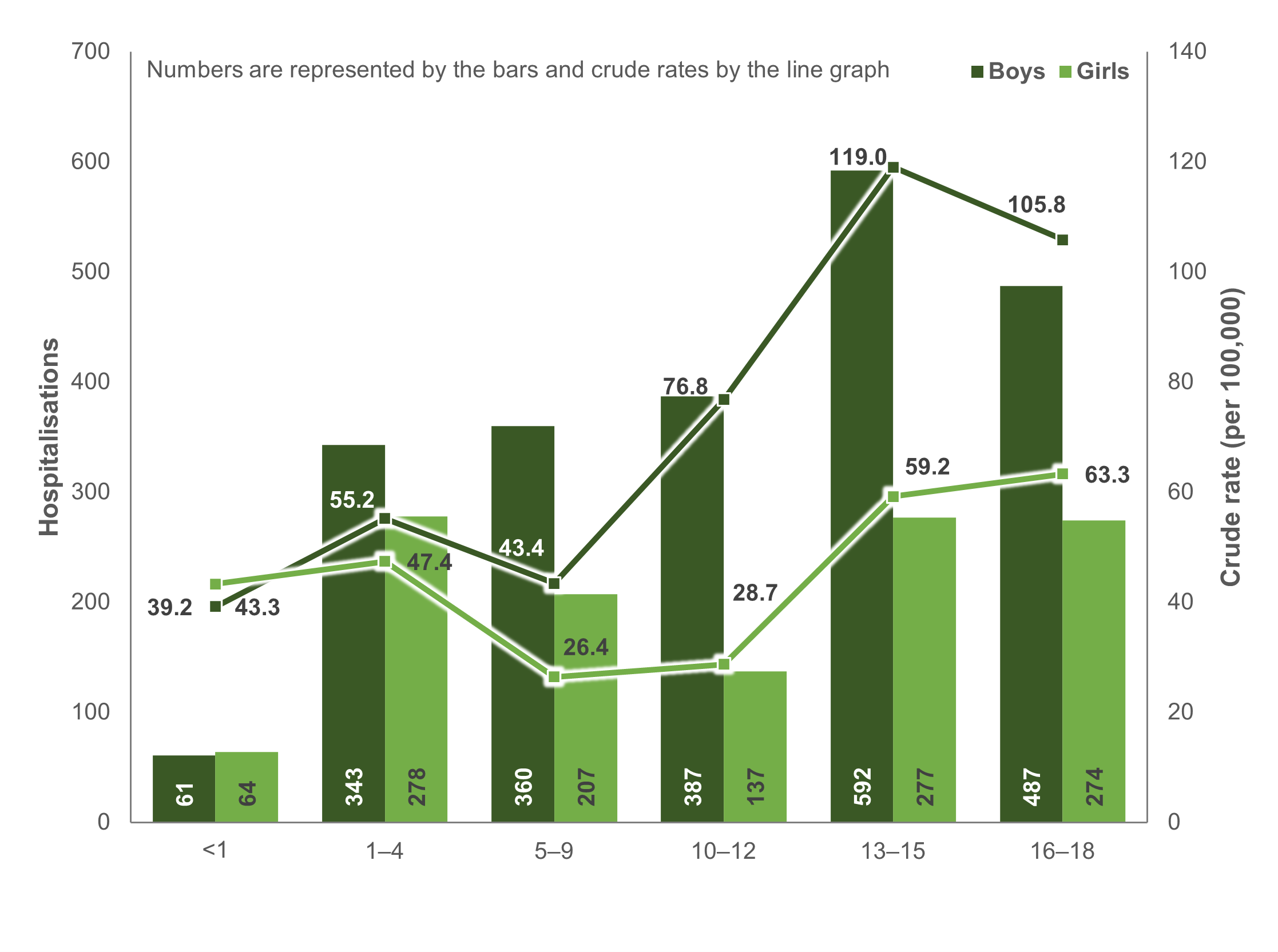Nature of injuries sustained
This chapter summarises:
- the main types of injury recorded during emergency department (ED) presentations and hospitalisations
- the body site of injury.
All figures presented in this chapter are for children aged 0–18 years only. Rate comparisons between child age groups and adults can be found in Injuries by developmental stage.
Boys had higher rates of injury hospitalisation across all types of injury with the notable exception of poisoning or toxic effect injuries, where girls were 2.8 times more likely to be hospitalised (74 and 205 per 100,000 respectively).
Fractures are the most common type of injury among children
Where specified, fractures and open wounds were the top 2 leading types of injury for both ED presentations and hospitalisations among children. Over a third of injury hospitalisations among children and adolescents were for fractures (36%) (Table 2a and 2b).
Children aged 10–12 have the highest rate of ED presentations for fractures (3,300 per 100,000), while for hospitalisations it is adolescents aged 13–15 (770 per 100,000). Over half of injuries caused by falls resulted in fractures (16,200, 51%).
| Injury ED presentations | n | % |
|---|---|---|
| Fractures | 132,237 | 22 |
| Open wounds | 103,156 | 17 |
| Soft-tissue injuries | 84,449 | 14 |
Notes: Denominators are the total number of injury emergency department presentations among children.
Source: AIHW National Non-admitted Patient Emergency Department Care (NNAPEDC) Database.
| Injury hospitalisations | n | % |
|---|---|---|
| Fractures | 32,066 | 36 |
| Open wounds | 18,060 | 20 |
| Poisoning or toxic effect | 8,288 | 9 |
Notes: Denominators are the total number of injury hospitalisations among children.
Source: AIHW National Hospital Morbidity Database.
The type of injury varies by age group and whether a child is hospitalised or presents to emergency department
For injury ED presentations, children aged 1–4 had the highest rate for 7 out of 16 injury types. In contrast, for injury hospitalisations, 16–18-year-olds had the highest rates of injury hospitalisation across the most injury types.
Figure 10 shows the age groups with the highest rates of injury across the top 5 most common injury types, for both ED presentations and hospitalisations.
Figure 10: Age groups with the highest rates of injury emergency department presentation and hospitalisation, for the top 5 most common injury types, Australia, 2021–22

Notes:
- Rates are crude per 100,000 population.
- Only includes records where the patient was between 0 and 18 years of age.
Sources: AIHW National Hospital Morbidity Database (NHMD), National Non-Admitted Patient Emergency Department Care (NNAPEDC) Database, and ABS National, state and territory population.
For more information please refer to supplementary data tables A7, A8 and A9.
Head and neck injuries are common in children
The ‘head and neck’ was the leading site of injury for injury ED presentations and hospitalisations (29%) (Tables 3a and 3b).
| Injury ED presentations | n | % |
|---|---|---|
| Head and neck | 175,421 | 29 |
| Wrist and hand | 108,568 | 18 |
| Shoulder and upper limb | 102,384 | 17 |
Notes: Denominators are the total number of injury ED presentations among children.
Source: AIHW National Non-admitted Patient Emergency Department Care (NNAPEDC) Database.
| Injury hospitalisations | n | % |
|---|---|---|
| Head and neck | 25,569 | 29 |
| Shoulder and upper limb | 19,259 | 22 |
| Wrist and hand | 13,511 | 15 |
Notes: Denominators are the total number of injury hospitalisations among children.
Source: AIHW National Hospital Morbidity.
Children aged 1–4 had the highest rate of head and neck injury ED presentations (6,100 per 100,000), with boys in this age group having the highest rate overall (7,100 per 100,000). Additionally, this age group had the highest rates of head and neck injury hospitalisations (750 per 100,000).
Open wounds were the most common type of injury to the head and neck across both ED presentations (33%) and hospitalisations (30%).
Boys had higher rates of injury hospitalisation across all sites of injury apart from injuries not described in terms of body location (85 and 220 per 100,000 respectively). Examples of injuries that cannot be assigned to a body region include injuries from poisoning or toxic effect, sunstroke, hypothermia and asphyxiation. For more information, see supplementary data table A10.
Concussions
Concussions in children is an issue of growing global awareness. Research has indicated that the brains of children and adolescents are more vulnerable to concussion impacts as they are still developing (Parker et al. 2021). Recovery time for concussions in younger age groups also appear to be longer than for adults (Manzanero et al. 2017). Physiological differences in children, such as thinner skulls, less developed neck muscles and a larger head-to-body ratio may contribute to this increased risk (van Ierssel et al. 2021).
There were 8,100 ED presentations and 3,500 hospitalisations for concussion among children. Boys made up the majority of both ED presentations and hospitalisations (64% each). Adolescents aged 13–15 had the highest rate of ED presentation (211 per 100,000) and hospitalisation (90 per 100,000) (Figure 11 and Figure 12).
Figure 11: Number and crude rate (per 100,000) of concussion injury emergency department presentations, by age and sex, Australia, 2021–22

Notes:
- Numbers are represented by the columns and rates by the line graph.
- Rates are crude per 100,000 population.
- Only includes records where the patient was between 0 and 18 years of age.
- Concussions are identified using the ICD-10-AM range S06.0 to S06.05
Sources: AIHW National Non-Admitted Patient Emergency Department Care (NNAPEDC) Database and ABS National, state and territory population.
Figure 12: Number and crude rate (per 100,000) of concussion injury hospitalisations, by age and sex, Australia, 2021–22
 Notes:
Notes:
- Numbers are represented by the columns and rates by the line graph.
- Rates are crude per 100,000 population.
- Only includes records where the patient was between 0 and 18 years of age.
- Concussions are identified using the ICD-10-AM range S06.0 to S06.05
Sources: AIHW National Hospital Morbidity Database (NHMD) and ABS National, state and territory population.
For information on sports-related concussions, see Activity.
Poisoning and toxic effect
Poisoning or toxic effect injuries can be caused by ingesting, inhaling or injecting harmful substances (which fall under the cause groups accidental poisoning, intentional self-harm, or undetermined intent), or by coming into contact with a venomous animal or plant (contact with living things).
Poisoning and toxic effect injuries are the only type of injury where girls are more likely than boys to be hospitalised. Of these 8,300 injury hospitalisations, girls made up 72% (6,000). Adolescents aged 16–18 have the highest rates of hospitalisation (377 per 100,000), with girls in this age group having the highest rate overall (595 per 100,000). Boys aged 1–4 and 5–9 have higher rates than girls in the same age group, however from age 10 onwards, girls have higher rates.
The leading type of poisoning among girls was Poisoning by nonopioid analgesics, antipyretics and antirheumatics (2,700, 44%) while for boys, it was Poisoning by psychotropic drugs, not elsewhere classified (420, 19%). Girls made up the majority (76%) of cases where the poisoning substance was medicinal in nature (T36–T50), while boys made up the majority of cases (54%) with toxic effects of non-medicinal substances (T51–T65). For more information, see supplementary data table A9.
Foreign objects (through orifice)
An orifice is an opening in the body that provides access to internal cavities, such as the mouth, nose or ear. Children very commonly get foreign objects stuck in these orifices, requiring medical intervention. Across child age groups, different orifices are more likely to be affected:
- over half of these cases in infants were for the respiratory tract (114, 51%)
- children aged between 1 and 12 were more likely to have a foreign body in the ear (855, 37%)
- the oesophagus was involved in around 1 in 5 of these cases among adolescents aged between 13 and 18 (122, 22%).
Manzanero S, Elkington L, Praet S, Lovell G, Waddington G & DC H (2017) Post-concussion recovery in children and adolescents: A narrative review, Journal of concussion, 1, doi: 10.1177/2059700217726874.
Parker K, Donovan M, Smith K & Noble-Hauesslein L (2021) Traumatic Injury to the Developing Brain: Emerging Relationship to Early Life Stress, Frontiers in Neurology, 12, doi: 10.3389/fneur.2021.708800.
van Ierssel J, Osmond M, Hamid J, Sampson M & Zemek R (2021) What is the risk of recurrent concussion in children and adolescents aged 5 – 18 years? A systematic review and meta-analysis, British Journal of Sports Medicine, 55, doi: 10.1136/bjsports-2020-102967.


